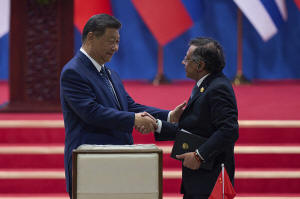|
Colombian President Gustavo Petro wrapped up a visit to China
this week with a stop in Shanghai, where he met with former
Brazilian President Dilma Rousseff, the head of the New
Development Bank.
The multilateral lender was set up a decade ago as a project of
Brazil, Russia, India, China and South Africa — the so-called
BRICS nations of major developing markets — as a counter to
U.S.-dominated institutions like the World Bank and
Inter-American Development Bank.
To date, the New Development Bank has approved loans for 122
infrastructure projects totaling more than $40 billion in areas
such as transport, sanitation and clean energy, according to
Rousseff.
Petro, speaking to reporters in China on Saturday, said that
Colombia is committed to purchasing $512 million worth of shares
in the bank. He said that he was especially excited by the
possibility of securing the New Development Bank's support for a
120-kilometer (75-mile) canal, or railway, connecting Colombia's
Atlantic and Pacific Ocean coastlines that he said would
position the country at the “heart” of trade between South
America and Asia.
Colombia is the second Latin American country to try and join
the bank after tiny Uruguay sought membership in 2021.
But Colombia's traditional role as a staunch U.S. ally and
caretaker in the war on drugs is likely to raise eyebrows in
Washington. The U.S. State Department this week said that it
would “vigorously oppose” financing of projects linked to
China's Belt and Road Initiative in Latin America. Petro signed
up to the initiative during a summit with fellow leftist leaders
from Brazil and China.
Petro, a former leftist guerrilla, said he wouldn't be dissuaded
by U.S. pressure and reaffirmed that Colombia seeks to remain
neutral in a new era of geopolitical wrangling.
“We made this decision freely,” Petro told reporters from
Shanghai. “With the United States we can speak face to face,
with China too.”
All contents © copyright 2025 Associated Press. All rights reserved

|
|




